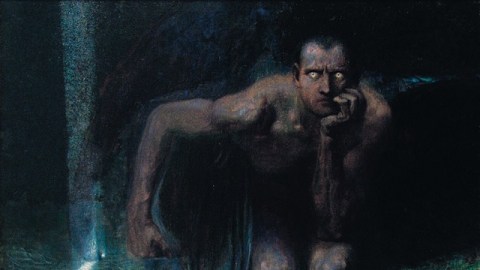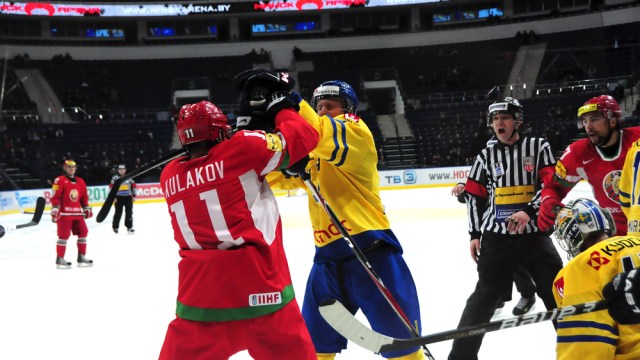Can Franz von Stuck Bring the Idea of the “Big” Artist Back?

“I am big,” Gloria Swanson’s fading film star Norma Desmond says in Sunset Boulevard. “It’s the pictures that got small.” Have we lost the “big” artist, the artist who tackled the big ideas of truth and life whose name stood on the tip of everyone’s tongue regardless of class or nationality? Franz von Stuck, known in the late 19th century as Munich’s “painter prince,” belonged to the highest rank of artistic royalty at the time, yet today his name’s as faded as that of most silent film stars. If we’ve lost not just such “big” artists of the past, but also the capacity to allow such “big” artists in the future, what have we also lost in the exchange of big pictures for small? On the 150th anniversary of von Stuck’s birth and the 120th anniversary of his American debut, the Frye Art Museum in Seattle, Washington, presents the exhibition Franz von Stuck (which runs through February 2, 2014), which recreates not just von Stuck’s art, but also the culturally charged atmosphere that powered the Gesamtkunstwerk—the total work of art that captures the total human condition. Can Franz von Stuck bring the idea of the “big” artist back?
von Stuck belongs to the Symbolist school that flourished in Europe in the late 19th century as a more psychological cousin to the Impressionism and later Post-Impressionism then evolving from radicalism to acceptance. In a 1912 interview reprinted in the exhibition’s catalogue, von Stuck expresses some admiration for Manet and early Monet, but his tastes truly tend toward fellow Symbolists and proto-Symbolists such as Arnold Böcklin, Puvis de Chavannes, Edward Burne-Jones, Jean-Jacques Henner, and Adolph Menzel. As to the most modern artists of the time, von Stuck felt Gauguin had ideas but poor execution, Cézanne was an interesting colorist but faulty draftsman, and Matisse was clever but “deliberately infantile,” while the Cubists such as Picasso were simply “quite mad.” “My gods?” Stuck repeats the interviewer’s question, then offers Michelangelo, Rubens, Velázquez, and Rembrandt as “the masters of all masters.” von Stuck wanted to play with the big boys, the artists who tapped into the spirit of their age and lay down deep, lasting roots. As the exhibition demonstrates, for von Stuck, it was go big or go home, an attitude backed up by talent that launched him into the top tier of artists of his time.
Stuck belonged to an era of big artists and visionaries. Richard Wagner’s Ring Cycle set the standard (perhaps forever) for the mind-blowingly big musical and theatrical work. Karl Marx championed class struggle as the determiner of political and economic power. Friedrich Nietzsche declared “God is dead” and revolutionized philosophy. Charles Darwin reached back in time and discovered natural selection to be the ruling force of life. Sigmund Freud reached into the mind and fathered the science of psychoanalysis. In the second half of the 19th century, such bold thinking desperately tried to keep up with the rapid pace of technological advances threatening to engulf human values.
But what was von Stuck’s big idea? “When choosing my subject matter, I seek to render only the purely human, the eternally valid—such as the relationship between man and woman,” the artist said in 1912. “Most of my paintings feature a ‘he’ and a ‘she.’ I would like to glorify the strength of man and the soft pliancy of woman. Even in my religious paintings, I seek to highlight the human aspect, that which is universally understandable. In my mind, a savage would be able to see that it is a noble man here (in my Kreuzigung [Crucifixion]) who is nailed to the cross between two barbarians.” As Jo-Anne Birnie Danzker, Director of the Frye Art Museum and former Director of the Museum Villa Stuck in Munich, writes in the foreword to the catalogue, “From Stuck’s earliest successes in the 1880s until his death in 1928, his painterly subjects oscillate between the Apollonian and the Dionysian, between odes to a world of fair appearances and celebrations of the ecstasy of excess and wild emotions. They conflate religious subjects, classical mythology, Freudian theory, and Darwinian concepts of the descent of man, the struggle for existence in the natural world, and the process of selection in relation to sex.” von Stuck’s big idea is humanity itself, in all its complexity and contradiction, all its passion and pain. In paintings such as Pieta, we bear witness to the Virgin Mary’s grief as we, too, look upon the dead body of Christ, to whom von Stuck often gave his own features in the paintings, thus placing himself in that most passionate and pathetic of roles.
But, just as Freud probed the darker, sexualized side of the human psyche, von Stuck walked and painted on the wild side. Die Sünde(Sin; 1893), one of von Stuck’s most powerful paintings and most popular during his lifetime, shows a seductive dark-haired “Eve” tempting you from the shadows to “bite the apple” once again with pure passion rather than any kind of malice. (If you’re wondering why a Seattle museum’s holding a show about a German artist, all you need to know is that Sin is in the Frye’s permanent collection.) Similarly, von Stuck’s Lucifer (1890; detail shown above) strikes the viewer not just as an embodiment of evil, but an embodiment of the human element in evil. An early critic wrote of “appalling Lucifer, sitting alone in the nether gloom with incandescent greenish eyes.” Prince Ferdinand of Bulgaria, once owner of Lucifer, told von Stuck that the painter “terrified” his ministers, who made the sign of the cross upon first sight of the fallen archangel—a story von Stuck retold with glee, one presumes. What makes Lucifer stick in your mind isn’t some reproduction of the glamour of evil, but rather the poignant sense of loss in those glowing green eyes, the envy of the heaven he fell from fueling the fires of the hell he must now fashion. von Stuck could paint both convincing Christs and Satans because he always held onto the common thread of the humanity at the core of such figures.
For some artists, such a relentless grasp of a common thread can quickly turn them into a one-hit wonder, but the true mark of a “big” artist is the ability to create whole worlds from that one idea. As the beautifully illustrated catalogue proves, von Stuck explored humanity not just in Heaven and Hell, but here on Earth in Biblical stories and ancient myths, as well as in the colorful traditions of Europe, including those of Spain. Perhaps the greatest “spin off” of von Stuck’s big idea in painting is his home, now the Museum Villa Stuck in Munich. In one of the catalogue essays, Danzker recreates the “total artwork” atmosphere of the von Stuck home he designed from the exterior right down to the furnishings. “It was the interior of the Villa Stuck, with its magnificent rooms, richly decorated walls and ceilings, painted sculptures, artist-designed furniture, and sumptuous atelier hung with Gobelin tapestries, that brought Stuck and his Villa international fame,” Danzker writes. Period photographs capture some of the luxuriousness of the home where “the cultural elite of the day” would travel for rarified communion. Musicians would regale those gathered in the Music Salon with Bach, Beethoven, and other giants of German music. Perhaps a little self-promotingly, von Stuck built “altars” to his own paintings Sin and Orpheus. Sadly damaged during World War II, the repaired and revitalized Villa Stuck stands today as a memorial to von Stuck’s vision. “The Villa Stuck was conceived as the physical embodiment of a restless individuality and as a worthy stage for, and an expression of, an artwork of the future,” Danzker concludes.
Unfortunately, “big” ideas can go terribly wrong. Any list that includes the names Wagner and Nietzche runs the risk of veering into fascist territory, and von Stuck’s art caught the eye of Adolf Hitler long after the artist died. Of course, Hitler saw only what he wanted to see, willfully misreading von Stuck the same way he willfully misread Wagner and others to serve his own nefarious ends. Ironically, von Stuck joined a call after World War I for the allies to forgive Germany precisely because of that same artistic heritage twisted by the Nazis barely two decades later. But if art is to mean anything again and speak to larger audiences, it must dare to mean the big things, the big truths of art such as those found in von Stuck. These days of small-bore exhibitions in which artists “engage in dialogue with” or “examine dialectics” threaten to bore the art world literally to death. But, as the exhibition Franz von Stuck more than proves, it’s hard to look away from works that strike us with “the purely human, the eternally valid,” as von Stuck put it. We may be dancing with the devil, but it’s truly a case of choosing the devil you know (as part of your own soul) over the devil you don’t.
[Image:Franz von Stuck. Lucifer (detail), 1890. Oil on canvas. 63 3/8 x 60 1/16 in. The National Gallery for Foreign Art, Sofia, Bulgaria.]
[Many thanks to the Frye Art Museum, Seattle, Washington, for providing me with the image above from, a review copy of the catalogue to, and other press materials relating to the exhibition Franz von Stuck, which runs through February 2, 2014.]





